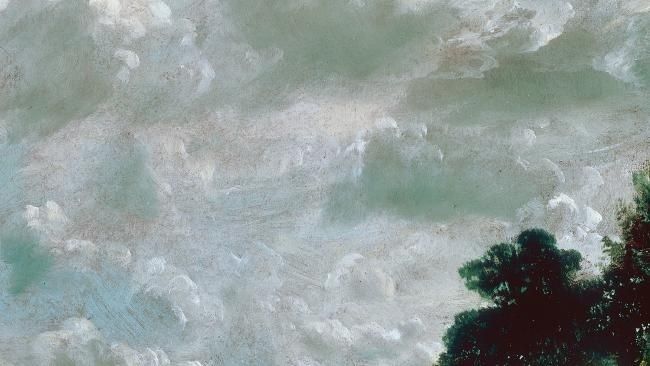Post by UKarchaeology on Nov 27, 2015 15:30:34 GMT
Interesting article...

Cloud Study (1821) by John Constable.
John Ruskin began his career believing “there is no such thing as bad weather, only different kinds of pleasant weather”. As well as being a brilliant art critic and an artist himself, Ruskin was also the most dedicated weather interpreter of 19th-century England.
As the years went by, however, and the weather of his time seemed to get gloomier and gloomier, he began to have his doubts. In two lectures he gave in 1884, published subsequently as The Storm Cloud of the Nineteenth Century, Ruskin prophesied “a disastrous breakdown in the covenant between man and nature”. Where formerly he’d seen the mystery of God’s creation in the sky, now he saw human error.
In contrast with Thomas Hardy, who at the time saw not spectres in the air but a realistic emptiness, Ruskin believed the weather had begun to look to be made “of dead men’s souls”.
Not surprisingly, Ruskin’s lectures received a mixed, even condescending response at the time. There is a way, however, in which the darkness of the Victorian age — the polemical fogs of Bleak House, the funereal “under-sky” of Tennyson — can be read as a dark forecast from the roots of the industrial era, of our own impending weather doom. For despite the fact Ruskin’s vision of “the light, the air, the waters, all defiled!” could hardly be called exact science, it is nevertheless true that the levels of sulphur dioxide in British air peaked in the very decade his lectures were given.
Notwithstanding his apocalyptic vision, Ruskin was undoubtedly a man of his times, a son who yearned to bottle clouds just as his father had bottled sherry. In her new book Weatherland: Writers & Artists Under English Skies, Alexandra Harris shows us how fascinating the weather has always been to us, as a science of the air and as a constantly shifting analog of our own perceptions and temperaments. Yes, the weather has always been a wild, and, to some, a godlike thing, replete with bucolic unpredictability and mythological import, with mystery and drama and Virgilian rhythm, serving not only as metaphor and foodstore but as moral guide.
Inevitably the drip drip drip of English rain returns as a refrain throughout these pages, as does the low sky over the squelchy field and the consolation of the warming hearth by which so many of the books and paintings Harris discusses were written and painted. Going as far back as the wintry Anglo-Saxon exile poetry of The Wanderer, she delineates surprising patterns in the history of England’s relationship with the weather, the cultural cloudbreaks and occlusions, the aesthetic breezes and corrective tempests. She surveys how these phenomena are rendered and interpreted, how they are inscribed into stone, printed on manuscripts, painted on canvases, conceptualised and curated, and analysed behind the barometer’s glass.
Full story: www.theaustralian.com.au/arts/review/weatherland-the-writers-and-artists-who-thrived-under-english-skies/story-fn9n8gph-1227623945035

Cloud Study (1821) by John Constable.
John Ruskin began his career believing “there is no such thing as bad weather, only different kinds of pleasant weather”. As well as being a brilliant art critic and an artist himself, Ruskin was also the most dedicated weather interpreter of 19th-century England.
As the years went by, however, and the weather of his time seemed to get gloomier and gloomier, he began to have his doubts. In two lectures he gave in 1884, published subsequently as The Storm Cloud of the Nineteenth Century, Ruskin prophesied “a disastrous breakdown in the covenant between man and nature”. Where formerly he’d seen the mystery of God’s creation in the sky, now he saw human error.
In contrast with Thomas Hardy, who at the time saw not spectres in the air but a realistic emptiness, Ruskin believed the weather had begun to look to be made “of dead men’s souls”.
Not surprisingly, Ruskin’s lectures received a mixed, even condescending response at the time. There is a way, however, in which the darkness of the Victorian age — the polemical fogs of Bleak House, the funereal “under-sky” of Tennyson — can be read as a dark forecast from the roots of the industrial era, of our own impending weather doom. For despite the fact Ruskin’s vision of “the light, the air, the waters, all defiled!” could hardly be called exact science, it is nevertheless true that the levels of sulphur dioxide in British air peaked in the very decade his lectures were given.
Notwithstanding his apocalyptic vision, Ruskin was undoubtedly a man of his times, a son who yearned to bottle clouds just as his father had bottled sherry. In her new book Weatherland: Writers & Artists Under English Skies, Alexandra Harris shows us how fascinating the weather has always been to us, as a science of the air and as a constantly shifting analog of our own perceptions and temperaments. Yes, the weather has always been a wild, and, to some, a godlike thing, replete with bucolic unpredictability and mythological import, with mystery and drama and Virgilian rhythm, serving not only as metaphor and foodstore but as moral guide.
Inevitably the drip drip drip of English rain returns as a refrain throughout these pages, as does the low sky over the squelchy field and the consolation of the warming hearth by which so many of the books and paintings Harris discusses were written and painted. Going as far back as the wintry Anglo-Saxon exile poetry of The Wanderer, she delineates surprising patterns in the history of England’s relationship with the weather, the cultural cloudbreaks and occlusions, the aesthetic breezes and corrective tempests. She surveys how these phenomena are rendered and interpreted, how they are inscribed into stone, printed on manuscripts, painted on canvases, conceptualised and curated, and analysed behind the barometer’s glass.
Full story: www.theaustralian.com.au/arts/review/weatherland-the-writers-and-artists-who-thrived-under-english-skies/story-fn9n8gph-1227623945035
